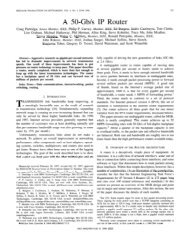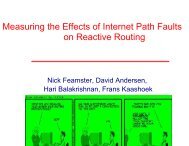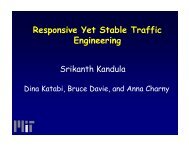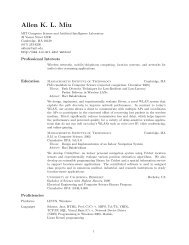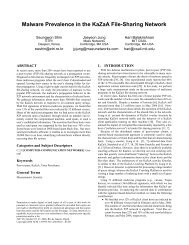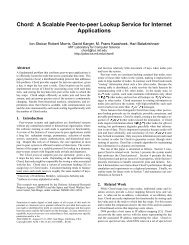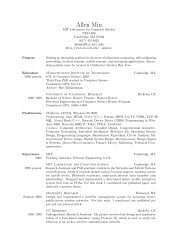Taming IP Packet Flooding Attacks - CiteSeerX
Taming IP Packet Flooding Attacks - CiteSeerX
Taming IP Packet Flooding Attacks - CiteSeerX
Create successful ePaper yourself
Turn your PDF publications into a flip-book with our unique Google optimized e-Paper software.
1 Introduction<br />
<strong>Taming</strong> <strong>IP</strong> <strong>Packet</strong> <strong>Flooding</strong> <strong>Attacks</strong><br />
Karthik Lakshminarayanan Daniel Adkins ¡<br />
Adrian Perrig Ion Stoica<br />
UC Berkeley UC Berkeley CMU UC Berkeley<br />
One of the major problems faced by Internet hosts is denialof-service<br />
(DoS) caused by <strong>IP</strong> packet floods. Hosts in the<br />
Internet are unable to stop packets addressed to them. Once<br />
a host’s network link becomes congested, <strong>IP</strong> routers respond<br />
to the overload by dropping packets arbitrarily. This is contrary<br />
to the goals of the host, which could respond more<br />
effectively to overload if it had control over which packets<br />
were dropped. For example, a host may reject new connections<br />
rather than accept excess load. A host running multiple<br />
services may give higher priority to some services than others<br />
(service differentiation). Also, a host may provide lower<br />
quality service rather than reject requests (service degradation).<br />
The main thesis of this paper is that hosts – not the network<br />
– should be given control to respond to packet floods<br />
and overload. Ideally, hosts should have fine-grained control<br />
over how routers process the packets addressed to them.<br />
For instance, hosts should be able to decide which packets<br />
to receive, which packets are dropped, and which packets<br />
are redirected. To illustrate this point, we show how hosts<br />
can implement the following useful defenses against packet<br />
flooding:<br />
¢ Avoid receiving packets at arbitrary ports.<br />
¢<br />
Contain the traffic of an application (service) under a<br />
flooding attack to protect the traffic of other applications.<br />
¢ Protect the traffic of established connections.<br />
¢ Throttle the rate at which new connections are opened.<br />
We present two possible realizations of the above defenses.<br />
One is based on the Internet Indirection Infrastructure [22],<br />
and the other is an <strong>IP</strong>-based solution in which hosts insert<br />
filters at the last hop <strong>IP</strong> router.<br />
The rest of the paper is organized as follows. In Section 2,<br />
we argue why hosts should be given fine-grained control<br />
£<br />
This research was sponsored by NSF under grant numbers Career<br />
Award ANI-0133811, and ITR Award ANI-0085879. Views<br />
and conclusions contained in this document are those of the authors<br />
and should not be interpreted as representing the official policies,<br />
either expressed or implied, of NSF, or the U.S. ¤<br />
government.<br />
Daniel Adkins is supported by a fellowship from the Fannie<br />
and John Hertz Foundation.<br />
1<br />
to respond to flooding attacks, and in the process specify<br />
the problem and goals. In Section 3, we demonstrate how<br />
hosts can defend themselves against flooding attacks using<br />
the ability to control how routers process packets in the network.<br />
We present two realizations of these responses in Section<br />
4. We present related work in Section 5 and conclude in<br />
Section 6.<br />
2 A case for host control<br />
The term “denial-of-service” was originally coined by<br />
Gligor [11] in the context of operating systems. It has<br />
since been associated with many types of network attacks.<br />
It refers to attacks that exploit protocol vulnerabilities<br />
(e.g., SYN flooding [19]), attacks that exploit implementation<br />
vulnerabilities (e.g., Teardrop [7]), and packet flooding<br />
(e.g., DDoS). Shields [20] gives a definition of network<br />
denial-of-service which captures all of these different attacks.<br />
In this paper, we focus on <strong>IP</strong> flooding attacks. Other DoS<br />
attacks can, in theory, be addressed at the hosts once the vulnerabilities<br />
are known. In contrast, hosts can do little against<br />
<strong>IP</strong> flooding attacks. <strong>IP</strong> flooding attacks are possible because<br />
hosts in the Internet have no control over which packets they<br />
receive. This problem is not unique to <strong>IP</strong>. Any entity in an<br />
open network with a public point of contact is vulnerable to<br />
flooding attacks.<br />
We specify our goals in addressing the <strong>IP</strong> flooding problem<br />
in terms of how the aggregate throughput of applications<br />
running on hosts varies with the incoming traffic rate.<br />
Figure 1 shows how the application throughput 1 varies with<br />
the amount of incoming traffic for a typical Internet host. As<br />
the incoming traffic increases, the application throughput increases.<br />
However, as the incoming traffic exceeds the capacity<br />
of the network link, packet loss will ultimately cause congestion<br />
collapse of the TCP traffic. In contrast, the optimal<br />
throughput curve would stay constant at the link capacity.<br />
Our goal is to make the throughput curve as close to optimal<br />
as possible. In this work, we do not focus on the mechanisms<br />
that hosts use to detect an attack. Instead, we focus on<br />
the mechanisms that hosts use to react once they determine<br />
that they are overloaded or under attack. Our central idea is<br />
to provide control to hosts over the packets they receive. Ide-<br />
1 The definition of throughput is application-specific. For example,<br />
it could be the number of connections satisfied per second.
Application throughput<br />
link capacity<br />
Optimal case<br />
Incoming traffic rate<br />
Typical<br />
Internet host<br />
Figure 1: Application throughput as a function of incoming<br />
traffic rate for (a) typical Internet host and (b) optimal case.<br />
ally, a host should be able to invoke responses that would<br />
have been possible had its network link not been congested.<br />
A natural question is why not implement more sophisticated<br />
drop policies at routers instead. We believe that such an approach,<br />
while useful, is too restrictive. Hosts inherently have<br />
more information about the type and the importance of the<br />
traffic they receive than the network does. This places hosts<br />
in the best position to respond to <strong>IP</strong> flooding attacks. Consider<br />
a host that runs two services and ¡ , and assume that<br />
the traffic to service ¡ surges abruptly causing congestion on<br />
the incoming link. The best possible response to this event<br />
may depend on knowledge available only to the host. If service<br />
¡ has higher priority than , and if the host believes<br />
that the surge is because of a flash crowd (e.g., ¡ is a web<br />
server that has just announced a new popular product), the<br />
host may decide to stop the traffic of the less important service<br />
. In contrast, if is the more important service and if<br />
the host believes that the surge is due to a DDoS attack, the<br />
host may choose to stop the traffic of ¡ . Because the traffic<br />
in the two cases appears to be the same to the network,<br />
it would be impossible for the network to have an optimal<br />
response to the congestion without input from the host.<br />
3 Responses to packet flooding<br />
In this section, we present some responses to packet floods<br />
which hosts can use to improve their application throughput.<br />
In particular, the hosts specify the action to be performed on<br />
different classes of packets, where each class is determined<br />
by information in the packet header. How a class is defined<br />
by an application depends on the implementation of these responses.<br />
For example, a class could be defined as the set of<br />
SYN packets that arrive on a particular port. While our general<br />
philosophy is to provide arbitrary control, in this section<br />
we seek to illustrate how useful properties can be achieved<br />
by simple responses.<br />
2<br />
A. Avoid receiving packets at arbitrary ports<br />
Internet hosts can receive unsolicited packets at ports where<br />
no service runs. Though these packets are dropped by the<br />
kernel, they consume network bandwidth and may affect<br />
other services. Thus, a host should receive packets only at<br />
ports on which it is listening or as part of an established<br />
connection. This response prevents arbitrary scanning of networks<br />
and also illegitimate packets sent to random ports.<br />
B. Contain the traffic of individual applications<br />
With the ability to decide which packets are dropped, hosts<br />
can contain the traffic of individual applications that might<br />
be under a flooding attack, thus protecting the other applications<br />
that run on the same host. 2 Let us consider the example<br />
of a host with two applications expecting requests,<br />
a web server and a transaction server. If either application<br />
is attacked, both are affected because they share a common<br />
network link. When incoming traffic exceeds the link capacity,<br />
the host should be able to decide which packets to drop<br />
depending on which service has higher priority. In our example,<br />
the host should be able to keep the transaction server<br />
running while possibly stopping the traffic to the web server.<br />
C. Protect the traffic of established connections<br />
To maximize the application throughput, hosts need to protect<br />
the traffic of established connections against arbitrary<br />
traffic. This makes it more difficult for an attacker to perform<br />
<strong>IP</strong> flooding attacks because it is harder to establish a<br />
connection and sustain the traffic on that connection rather<br />
than send arbitrary packets. This is because establishing a<br />
connection requires the attacker to handle data and signaling<br />
packets (e.g., ACK, SYN ACK packets) from the victim.<br />
D. Throttle rate of connection setup<br />
While the previous defense protects the established connections,<br />
it is still difficult for legitimate clients to open new<br />
connections in the presence of DoS attacks. To alleviate this<br />
problem, a host under attack should be able to reduce the<br />
fraction of connection attempts made by the attacker. One<br />
way to achieve this goal is to make it harder for a client to<br />
open a new connection by using cryptographic puzzles [17]<br />
or captchas [23]. While this approach will throttle the rate of<br />
connection setup of all clients, it will a have a much greater<br />
effect on the attacker than on legitimate clients. This is because<br />
a legitimate client opens, in general, far fewer connections<br />
than an attacking host does.<br />
2 We are not referring to bandwidth sharing between conformant<br />
flows which systems such as Congestion Manager [5] achieve.
Attacker<br />
(A)<br />
x1 V<br />
x2 V<br />
x3 V<br />
x4 V<br />
Victim<br />
(V)<br />
Attacker<br />
(A)<br />
(a) (b)<br />
x3 V<br />
x4 V<br />
Victim<br />
(V)<br />
Figure 2: (a) <strong>Flooding</strong> attack via victim’s public triggers. (b)<br />
Dilute the attack by dropping two of the four public triggers.<br />
4 Two realizations<br />
In this section, we first demonstrate how the defenses described<br />
in the previous section can be realized using the Internet<br />
Indirection Infrastructure ( ¢¡ [22]). Using the ideas<br />
that embody this solution, we then propose a mechanism that<br />
does not require an indirection layer. It only requires that<br />
ISPs allow hosts to add filters at their last hop router.<br />
4.1 £¥¤ -based approach<br />
The first solution is based on ¢¡ , an indirection layer that<br />
gives hosts control over which packets they receive by using<br />
a rendezvous primitive. The use of ¦¡ provides a method of<br />
identifying hosts without using <strong>IP</strong>. Our choice of ¦¡ for the<br />
indirection layer was influenced by our familiarity with it.<br />
For ease of exposition, we use the notation in [22]. We only<br />
need to know a subset of the capabilities of ¢¡ , which we<br />
summarize here.<br />
1. Sources send packets to a logical identifier and receivers<br />
express interest in packets by inserting a trigger into the<br />
network.<br />
2. <strong>Packet</strong>s are of the form §©¨¢ and triggers are of the<br />
form §¨ , where is either an identifier or an<br />
<strong>IP</strong> address. Given a packet §¨¦ , ¦¡ will search for<br />
a trigger §¨ and forward ¦ to .<br />
3. If a host wants to stop receiving packets from a particular<br />
trigger, it can simply remove that trigger.<br />
4. Client-server communication: Servers that expect connections<br />
from arbitrary clients must have triggers whose<br />
identifiers are well-known. These triggers are called<br />
public triggers Once a client contacts a server through<br />
its public trigger, they exchange a pair of identifiers<br />
which they use for the remainder of the communication.<br />
Triggers corresponding to these identifiers are referred<br />
to as private triggers.<br />
We now discuss in detail how hosts can use ¢¡ to achieve the<br />
desired defenses.<br />
Avoid receiving packets at arbitrary ports. Clients in ¦¡<br />
can hide their <strong>IP</strong> addresses and publish the identifiers of only<br />
their public triggers. We assume here that it is very hard for<br />
the attacker to find the <strong>IP</strong> address by other means.<br />
3<br />
Contain the traffic of individual applications. The traffic<br />
of different applications can be distinguished from one another<br />
by the triggers used for communication. For example,<br />
each application could have a different public trigger, or each<br />
client contacting a server could do so with a different private<br />
trigger. To contain the traffic of an application, we could associate<br />
a drop probability with each trigger. If an application<br />
is attacked or becomes overloaded, we could raise the drop<br />
probability of its triggers to reduce its traffic. If necessary,<br />
we could disconnect the application entirely by setting the<br />
drop probability to zero or by removing its triggers.<br />
Even though ¢¡ does not associate drop probabilities with<br />
triggers, we can emulate the effect with multiple triggers<br />
(Figure 2). A server has a total of public triggers, and each<br />
client is expected to randomly choose one of these triggers<br />
when it attempts to connect. The server, however, at any time<br />
maintains only a subset of the triggers, thus effecting a<br />
drop rate of . The set of triggers that the server maintains<br />
is changed rapidly over time so that the attacker does<br />
not have time to find out which triggers are active and respond<br />
accordingly. This would imply that a fraction <br />
of the traffic (both attacker and legitimate) corresponding to<br />
that particular server is dropped. Note that it is not necessary<br />
that a client know the active triggers. If a client fails to<br />
connect it can simply retry with another trigger. The client<br />
will eventually connect after approximately tries. For<br />
further details, we refer the interested reader to our technical<br />
report [1].<br />
Protect the traffic of established connections. In ¢¡ , a<br />
client can send packets to a host only using the host’s public<br />
triggers or the private triggers corresponding to the client’s<br />
connections. The host can protect the traffic of its established<br />
connections by dropping some of the packets destined to the<br />
public triggers. Using the notation in the above example, a<br />
host while maintaining of its public triggers can choose<br />
an appropriate value of such that the traffic of its established<br />
connections is not affected.<br />
Throttle rate of connection setup. Consider a server that<br />
is under a flooding attack. can use indirection to redirect<br />
traffic to a powerful third party server , called a gatekeeper,<br />
which shields the server from the attack (Figure 3). The<br />
gatekeeper gives cryptographic puzzles to the client which<br />
have to be solved in order to contact the server. This will<br />
considerably slow down attacking hosts that attempts to open<br />
a large number of connections. In contrast, the impact this<br />
has on a typical client which opens very few connections<br />
will be small.<br />
To implement this defense, server stores a private trigger<br />
§ where is known only to the gatekeeper . In turn,<br />
inserts a public trigger § and advertises as being the<br />
public ID of server . When a client wants to contact , <br />
sends a message to ID . This message is in turn delivered to<br />
(step 1 in Figure 3). Upon receiving this message, sends
Gate-keeper (A)<br />
Client (C)<br />
1<br />
C id<br />
3<br />
2<br />
x A<br />
t S<br />
Server (S)<br />
Figure 3: Slowing down a DoS attack on public triggers.<br />
When a client wants to contact a server , it must first<br />
solve a puzzle before the gatekeeper will forward its<br />
packet to .<br />
a cryptographic puzzle back to client via the private trigger<br />
§¨ that was inserted by the client (step 2 in Figure 3).<br />
Client then solves the puzzle and sends the answer back<br />
to ID . Upon receiving this message, verifies that has<br />
solved the puzzle and forwards the packet to ID (step 2 in<br />
Figure 3). Finally, the packet is delivered to server which<br />
allocates a private trigger for client as before.<br />
To avoid replay attacks, will respond to each message with<br />
a unique puzzle. Once it sends the puzzle, stores it and<br />
waits for a reply. On receiving the reply (i.e., the solution<br />
to the puzzle), removes the puzzle. Of course, if does<br />
not receive a reply within a specific period of time, will<br />
remove the puzzle from its list.<br />
We also note that these schemes would be adopted by servers<br />
only when under attack. Hence, under normal operation,<br />
clients will not have the burden of either solving cryptographic<br />
puzzles or trying multiple times to reach a server.<br />
In this section, we have shown how hosts can protect themselves<br />
by controlling which packets they receive. However,<br />
this is only half the solution. It is a challenge to design an<br />
indirection layer which is itself robust to DoS attacks, i.e.,<br />
one should not be able to use the indirection primitives that<br />
the infrastructure exports to attack either the infrastructure<br />
or the hosts. A solution to address this challenge is presented<br />
in [1].<br />
4.2 <strong>IP</strong>-based approach<br />
In this section, we present how the indirection-based filtering<br />
techniques can be extended to the Internet with minimal<br />
changes to edge routers directly connected to the end-hosts.<br />
The practical viability of these techniques and whether ISPs<br />
would be willing to install them are discussed at the end of<br />
this section.<br />
We make the following assumptions: (i) The edge ISP is better<br />
provisioned than the host so that it may sustain attack<br />
traffic, (ii) The ISP is willing to install filters on the host’s<br />
behalf, (iii) ISP filters must be modified to enable the port<br />
that the server runs on to allow incoming traffic, (iv) Un-<br />
4<br />
modified clients would be able to connect to the servers in<br />
the normal case, but may need to do special work (like extra<br />
computation of cryptographic puzzles) when the server they<br />
contact is experiencing a flooding attack.<br />
The basic idea of the solution is to provide a configurable<br />
white list of allowed ports at the edge-router directly connected<br />
to the hosts. Configuration settings include which<br />
ports to open, the rate at which bandwidth needs to be shared<br />
across different ports, etc. Also, to allow unmodified applications<br />
to use the mechanisms, the edge-routers perform minimal<br />
NAT-like functionality to setup white lists of connections<br />
that are legitimately setup using the public ports where<br />
services are run at the hosts.<br />
Edge-routers that are directly connected to hosts need to<br />
maintain per-flow state on behalf of the hosts, i.e., if ¡<br />
is the<br />
edge-router through which all packets destined for must<br />
pass, then ¡ maintains per-flow state for . We now explain<br />
the mechanisms in the context of the responses that it allows<br />
for hosts.<br />
Avoid receiving packets at arbitrary ports. instructs ¡<br />
<br />
<br />
to allow traffic on certain public ports only. This functionality<br />
is similar to port forwarding that many NAT-based firewalls<br />
allow. Once a client establishes a connection to<br />
(by using a port that is white listed by in ¡<br />
), ¡ <br />
will maintain<br />
state to allow ’s packets through to . ¡<br />
can do this<br />
transparently in the same manner as a NAT does. When the<br />
connection is terminated, ¡<br />
removes the associated state. <br />
also has the power to stop malicious clients by terminating<br />
their connections.<br />
Contain the traffic of individual applications. can specify<br />
how exactly to split the bandwidth among its various applications.<br />
This functionality is similar to traffic shaping that<br />
many routers already implement.<br />
Protect the traffic of established connections. can ask<br />
¡<br />
to reserve a fraction of ’s bandwidth for established con-<br />
nections. Under congestion, ¡ will shape traffic according to<br />
the rules that has specified. ¡ will limit the rate of packets<br />
to ’s public ports in order to ensure that ’s ongoing<br />
connections will receive their reserved bandwidth.<br />
Throttle rate of connection setup. For redirecting traffic to<br />
gatekeepers, one can use DNS (like Akamai does) to send the<br />
traffic to the gatekeeper. In fact, the edge routers, if modified<br />
further, can themselves act as gatekeepers.<br />
4.3 £¥¤ -based approach vs. <strong>IP</strong>-based approach<br />
Generality. The indirection primitive that ¢¡ exports provides<br />
a clean mechanism for hosts to exercise control. Furthermore,<br />
the indirection primitive gives an elegant way of<br />
redirecting traffic seamlessly to a third party which would<br />
require DNS hacks for implementing in <strong>IP</strong>. In contrast, in<br />
the <strong>IP</strong>-based solution, the use of <strong>IP</strong> addresses combined with<br />
port numbers to identify services running on a host is not
general enough. In particular, the filters are not pushed arbitrarily<br />
into the network. 3<br />
Deployability. The indirection-based approach assumes the<br />
existence of an infrastructure such as ¦¡ . As we show in an<br />
earlier paper [22], such an infrastructure would greatly simplify<br />
deployment of a wide range of <strong>IP</strong> services, as well as<br />
enable the deployment of the flooding attack prevention techniques<br />
we outline in this paper.<br />
The <strong>IP</strong>-based solution, on the other hand, requires changing<br />
the edge router of the ISP that provides service to the host.<br />
It also assumes that the ISP is willing to cooperate with the<br />
hosts by allowing them to install filters into the ISP network.<br />
This technique is, however, incrementally deployable in the<br />
Internet. Whether ISPs would allow this is a separate issue<br />
which we do not address in this paper.<br />
5 Related work<br />
The proposed solutions to prevent DoS attacks can be<br />
roughly divided into two classes: <strong>IP</strong>-level and overlay-based.<br />
<strong>IP</strong>-level techniques are based upon traceback [6, 8, 18, 21]<br />
and pushback [16], both of which require router support. The<br />
goal of <strong>IP</strong> traceback is to detect the source of DoS attacks<br />
even when the attacker spoofs source addresses. It is complementary<br />
to our work as it provides an additional level of<br />
support for filtering illegitimate packets at the <strong>IP</strong> layer. With<br />
the pushback technique, routers identify the offending traffic<br />
aggregate and then push filters to upstream routers to limit<br />
the aggregate near its origin. In contrast to our mechanisms,<br />
pushback operates at a coarse level and treats all packets of<br />
the aggregate identically. Another <strong>IP</strong>-level approach is Path<br />
Identification (Pi), where routers mark packets that enables<br />
the victim to detect spoofed source addresses and to filter out<br />
malicious traffic [25].<br />
Jamjoom and Shin [13] noted that during flash crowds, traditional<br />
drop policies hurt TCP throughput. Their solution, persistent<br />
dropping, uses filters in <strong>IP</strong> routers to isolate TCP SYN<br />
packets from TCP packets of ongoing connections. Their solution<br />
is effective against flash crowds, but not against DDoS<br />
where the traffic is not necessarily TCP.<br />
Anderson et al. [3] prevent packet flooding by requiring<br />
clients to get tokens before contacting a server. The use of tokens<br />
allows for a coarse-grained bandwidth reservation policy.<br />
In contrast, we advocate for giving hosts far more control<br />
over the policy. For example, in our solution a host can easily<br />
differentiate between the traffic of established connections<br />
and the traffic of new connections, or between the traffic of<br />
two applications running at the same host.<br />
Secure Overlay Services (SOS) [15] was the first solution<br />
to explore the idea of using overlay networks for proac-<br />
3 Indeed, in the Internet white lists have to be pushed completely<br />
into the network to be effective, whereas black lists can be pushed<br />
only where required.<br />
5<br />
tively defending against DoS attacks. SOS protects hosts<br />
from flooding attacks by (i) installing filters at the ISP providing<br />
connectivity to the host and (ii) using an overlay network<br />
to authenticate the users. Mayday [2] generalizes this<br />
architecture and analyzes the implications of choosing different<br />
filtering techniques and overlay routing mechanisms.<br />
However, these solutions assume that the set of authorized<br />
users is known in advance, and that the set changes infrequently<br />
so that updating the authentication rules in the overlay<br />
nodes occurs rarely. Their solutions would not extend to<br />
a general <strong>IP</strong> setting (e.g., for a web server) where it is not<br />
always meaningful to speak of authorized users.<br />
The first use of cryptographic puzzles is due to Merkle [17],<br />
who used puzzles for the first instantiation of a public key<br />
protocol. Dwork et al. propose puzzles to discourage spammers<br />
from sending junk email [10]. Juels et al. used puzzles<br />
to prevent SYN flooding [14]. Aura et al. [4] and Dean and<br />
Stubblefield [9] and Wang and Reiter [24] propose puzzles to<br />
defend against DoS on the initial authentication. Gligor [12]<br />
analyzes the waiting time guarantees that different puzzle<br />
and client challenge techniques provide.<br />
6 Conclusion<br />
In the current Internet, hosts are practically defenseless<br />
against <strong>IP</strong> flooding attacks, as a sufficient amount of malicious<br />
traffic exhausts the last-hop link capacity and renders<br />
the link unusable. The reason flooding attacks can occur is<br />
that a host is unable to control which packets it receives.<br />
We find that end-hosts are in the best position to detect and<br />
react to DoS attacks. Thus, we present two proposals that<br />
allow hosts to take control of its incoming traffic. One mechanism<br />
relies on an indirection infrastructure that provides a<br />
general and architecturally clean solution. Our second solution,<br />
which is incrementally deployable in the Internet, relies<br />
on host and ISP collaboration, where the host can control<br />
fine-grained network filters on the last hop router.<br />
Our solutions have the immediate benefit that victims of DoS<br />
attacks can start defending themselves. Another benefit is<br />
that hosts without server functionalities cannot be attacked<br />
by arbitrary attackers any more, as a host would enable packets<br />
only those connections that it has established. This would<br />
rule out many flavors of worms that attack hosts which are<br />
not servers. Only servers that can be contacted by arbitrary<br />
hosts need a rendezvous mechanism. Our solutions constrain<br />
attackers to attack through that narrow interface, thus protecting<br />
the ongoing connections.<br />
However, there are still some questions that remain open.<br />
While we advocate full control over packets, neither of the<br />
two realizations we propose achieve it. They approximate<br />
that notion by classifying packets based upon information in<br />
headers such as port numbers or IDs. The natural question<br />
that arises is how much control is necessary for hosts and at<br />
what cost will this control come. Another point is that our
methods help hosts cope with packet floods directed at them,<br />
but do not protect the network itself. Ultimately, we need<br />
to identify the source of DDoS attacks and stop them at the<br />
entry points in the network.<br />
We hope that our insights will influence the design of future<br />
networks to be robust to DoS attacks.<br />
7 Acknowledgments<br />
We thank Mark Handley, Kevin Lai, Sridhar Machiraju and<br />
Michael Walfish for useful discussions and comments about<br />
the paper. We also thank the anonymous reviewers for their<br />
insightful comments that helped improve the paper.<br />
References<br />
[1] D. Adkins, K. Lakshminarayanan, A. Perrig, and I. Stoica.<br />
Towards a more functional and secure network infrastructure.<br />
Technical Report CSD-03-1242, UC Berkeley, 2003.<br />
[2] D. G. Andersen. Mayday: Distributed filtering for Internet<br />
services. In USITS, Seattle, WA, 2003.<br />
[3] T. Anderson, T. Roscoe, and D. Wetherall. Preventing Internet<br />
denial-of-service with capabilities. In Proc. of Hotnets-II,<br />
Cambridge, MA, Nov. 2003.<br />
[4] T. Aura, P. Nikander, and J. Leiwo. DoS-resistant authentication<br />
with client puzzles. In Security Protocols—8th International<br />
Workshop, Lecture Notes in Computer Science,<br />
Cambridge, United Kingdom, Apr. 2000. Springer-Verlag.<br />
[5] H. Balakrishnan, H. Rahul, and S. Seshan. An integrated congestion<br />
management architecture for Internet hosts. In Proc.<br />
of ACM SIGCOMM ’99, Cambridge, MA, Sept. 1999.<br />
[6] S. Bellovin, M. Leech, and T. Taylor. ICMP traceback messages,<br />
Internet draft, Work in progress, February 2003.<br />
[7] CERT Advisory CA-97.28. <strong>IP</strong> denial-of-service attacks, Dec.<br />
1997.<br />
[8] D. Dean, M. Franklin, and A. Stubblefield. An algebraic approach<br />
to <strong>IP</strong> traceback. Information and System Security,<br />
5(2):119–137, 2002.<br />
[9] D. Dean and A. Stubblefield. Using client puzzles to protect<br />
TLS. In Proc USENIX Security Symposium, 2001.<br />
[10] C. Dwork and M. Naor. Pricing via processing or combatting<br />
junk mail. In E. Brickell, editor, Advances in Cryptology<br />
— CRYPTO ’92, volume 740 of Lecture Notes in Computer<br />
Science, pages 139–147. International Association for Cryptologic<br />
Research, Springer-Verlag, 1993.<br />
[11] V. D. Gligor. A note on the denial of service problem. In Proc.<br />
of 1983 Symposium on Security and Privacy, pages 139–149.<br />
IEEE, 1983.<br />
[12] V. D. Gligor. Guaranteeing access in spite of service-flooding<br />
attacks. In Proceedings of the Security Protocols Workshop,<br />
Apr. 2003.<br />
[13] H. Jamjoom and K. G. Shin. Persistent dropping: An efficient<br />
control of traffic aggregates. In Proc. of ACM SIGCOMM ’03,<br />
pages 287–297, Karlsruhe, Germany, Aug. 2003.<br />
[14] A. Juels and J. Brainard. Client puzzles: A cryptographic<br />
countermeasure against connection depletion attacks. In<br />
Proc. of the Symposium on NDSS, 1999.<br />
[15] A. Keromytis, V. Misra, and D. Rubenstein. SOS: Secure<br />
Overlay Services. In Proc. of ACM SIGCOMM, Aug. 2002.<br />
6<br />
[16] R. Mahajan, S. M. Bellovin, S. Floyd, J. Ioannidis, V. Paxson,<br />
and S. Shenker. Controlling high bandwith aggregates in the<br />
network. ACM Computer Communication Review, 32(3):62–<br />
73, July 2002.<br />
[17] R. Merkle. Secure communication over insecure channels.<br />
Commun. ACM, 21(4):294–299, Apr. 1978.<br />
[18] S. Savage, D. Wetherall, A. Karlin, and T. Anderson. Practical<br />
network support for <strong>IP</strong> traceback. In Proc. of ACM SIG-<br />
COMM 2000, pages 295–306, Stockholm, Sept. 2000.<br />
[19] C. L. Schuba, I. V. Krsul, M. G. Kuhn, and E. H. Spafford.<br />
Analysis of a denial of service attack on TCP. In Proc. of<br />
IEEE Symposium on Security and Privacy, May 1997.<br />
[20] C. Shields. What do we mean by network denial-of-service?<br />
In Proc. of the 2002 IEEE Workshop on Information Assurance<br />
and Security, West Point, NY, June 2002.<br />
[21] D. Song and A. Perrig. Advanced and Authenticated Marking<br />
Schemes for <strong>IP</strong> Traceback. In Proc of IEEE INFOCOM,<br />
2001.<br />
[22] I. Stoica, D. Adkins, S. Zhuang, S. Shenker, and S. Surana.<br />
Internet Indirection Infrastructure. In Proc. of ACM SIG-<br />
COMM 2002, pages 10–20, Pittsburgh, PA, Aug. 2002.<br />
[23] L. von Ahn, M. Blum, N. Hopper, and J. Langford. Captcha:<br />
Using hard AI problems for security. In Eurocrypt, 2003.<br />
[24] X. Wang and M. K. Reiter. Defending against denial-ofservice<br />
attacks with puzzle auctions. In Proceedings of the<br />
2003 IEEE Symposium on Security and Privacy, May 2003.<br />
[25] A. Yaar, A. Perrig, and D. Song. Pi: A Path Identification<br />
Mechanism to Defend against DDoS <strong>Attacks</strong>. In IEEE Symposium<br />
on Security and Privacy, May 2003.




